New images of a relatively nearby protoplanetary disk, taken by the Subaru telescope on Mauna Kea, show strange banana-shaped arcs surrounding the central core. The most likely explanation for these arcs is that there’s another object orbiting the star; either a companion star or a large planet, and the gravitational interaction of this companion is distorting the disk of material. The protoplanetary disk, known as HT142527, is located 650 light-years away from Earth.
Continue reading “Protoplanetary Disk Warped by a Hidden Companion”
Rotating Disk Could Contain Newly Forming Planets
Astronomers from the University of St. Andrews have found evidence that a ring of dust around nearby Epsilon Eridani is rotating. The observations were made using the Submillimetre Common User Bolometer Array (SCUBA), which images the sky in the near infrared spectrum. This gives evidence to the theory that the disks of gas we see around newborn stars will eventually go on to become planets. In fact, the clumps of material tracked by the astronomers could even be newly forming planets themselves, still embedded in a vast disk of gas and dust.
Continue reading “Rotating Disk Could Contain Newly Forming Planets”
How Super Earths Might Form
Although our Solar System only contains a “regular Earth”, astronomers predict that other systems could contain “super Earths”; rocky planets with several times the mass of our planet. A new theory predicts that these planets should be most commonly found orbiting red dwarf stars. As red dwarf stars have less mass, they’re unable to hang onto the lighter gas that go onto form gas giants. The remaining heavier elements have time to form very massive terrestrial planets.
Continue reading “How Super Earths Might Form”
Large Amounts of Carbon Around a Distant Star
Astronomers have discovered a solar system with an unusually high amount of carbon; it could be at the stage where the rocky planets are forming. The system, called Beta Pictoris, is located 63 light-years from Earth and has a central star with twice the mass of our Sun. NASA’s FUSE (Far Ultraviolet Spectroscopic Explorer) and Hubble observed that gas around the star matches the composition of our own Solar System quite well. The stars intense radiation should be driving this gas away, but ionized carbon atoms are acting as a brake to keep it contained.
Continue reading “Large Amounts of Carbon Around a Distant Star”
Metal in Planets Depends on Their Stars
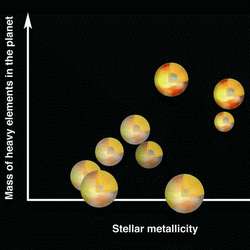
Correlation between the heavy elements in transiting planets and the metallicity of their parents. Image credit: A&A. Click to enlarge
Of the 188 extrasolar planets discovered, 10 are transits; we see them because they dim their parent star as they pass in front. This gives astronomers an opportunity to study the actual composition of these planets. European astronomers have discovered that the metal content of these “hot Jupiters” depends on the amount of metal in their parent star, which changes the size of their cores.
A team of European astronomers, led by T. Guillot (CNRS, Observatoire de la Cote d’Azur, France), will publish a new study of the physics of Pegasids (also known as hot Jupiters) in Astronomy & Astrophysics. They found that the amount of heavy elements in Pegasids is correlated to the metallicity of their parent stars. This is a first step in understanding the physical nature of the extrasolar planets.
Up to now, astronomers have discovered 188 extrasolar planets, among which 10 are known as “transiting planets”. These planets pass between their star and us at each orbit. Given the current technical limitations, the only transiting planets that can be detected are giant planets orbiting close to their parent star known as “hot Jupiters” or Pegasids. The ten transiting planets known thus far have masses between 110 and 430 Earth masses (for comparison, Jupiter, with 318 Earth masses, is the most massive planet in our Solar System).
Although rare, transiting planets are the key to understanding planetary formation because they are the only ones for which both the mass and radius can be determined. In principle, the obtained mean density can constrain their global composition. However, translating a mean density into a global composition needs accurate models of the internal structure and evolution of planets. The situation is made difficult by our relatively poor knowledge of the behaviour of matter at high pressures (the pressure in the interiors of giant planets is more than a million times the atmospheric pressure on Earth). Of the nine transiting planets known up to April 2006, only the least massive one could have its global composition determined satisfactorily. It was shown to possess a massive core of heavy elements, about 70 times the mass of the Earth, with a 40 Earth-mass envelope of hydrogen and helium. Of the remaining eight planets, six were found to be mostly made up of hydrogen and helium, like Jupiter and Saturn, but their core mass could not be determined. The last two were found to be too large to be explained by simple models.
Considering them as an ensemble for the first time, and accounting for the anomalously large planets, Tristan Guillot and his team found that the nine transiting planets have homogeneous properties, with a core mass ranging from 0 (no core, or a small one) up to 100 times the mass of the Earth, and a surrounding envelope of hydrogen and helium. Some of the Pegasids should therefore contain larger amounts of heavy elements than expected. When comparing the mass of heavy elements in the Pegasids to the metallicity of the parent stars, they also found a correlation to exist, with planets born around stars that are as metal-rich as our Sun and that have small cores, while planets orbiting stars that contain two to three times more metals have much larger cores. Their results will be published in Astronomy & Astrophysics.
Planet formation models have failed to predict the large amounts of heavy elements found this way in many planets, so these results imply that they need revising. The correlation between stellar and planetary composition has to be confirmed by further discoveries of transiting planets, but this work is a first step in studying the physical nature of extrasolar planets and their formation. It would explain why transiting planets are so hard to find, to start with. Because most Pegasids have relatively large cores, they are smaller than expected and more difficult to detect in transit in front of their stars. In any case, this is very promising for the CNES space mission COROT to be launched in October, which should discover and lead to characterization of tens of transiting planets, including smaller planets and planets orbiting too far from their star to be detected from the ground.
What of the tenth transiting planet? XO-1b was announced very recently and is also found to be an anomalously large planet orbiting a star of solar metallicity. Models imply that it has a very small core, so that this new discovery strengthens the proposed stellar-planetary metallicity correlation.
Original Source: NASA Astrobiology
Amateur Team Finds an Extrasolar Planet
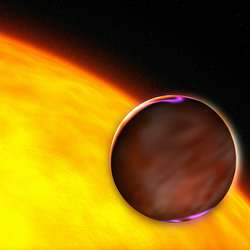
Artist’s Concept of Transiting Planet XO-1b. Image credit: NASA/ESA/STScI. Click to enlarge
Amateur astronomers have used inexpensive equipment to discover a Jupiter-sized planet orbiting a Sun-like star 600 light-years away. The team used the “transit method”, to watch how a star dims slightly as a planet passes in front. An automated telescope observed tens of thousands of bright stars, and then the team chose a few dozen promising candidates. The new planet, dubbed X0-1b is the 10th planet ever discovered using the transit method.
An international team of professional and amateur astronomers, using simple off-the-shelf equipment to trawl the skies for planets outside our solar system, has hauled in its first “catch.”
The astronomers discovered a Jupiter-sized planet orbiting a Sun-like star 600 light-years from Earth in the constellation Corona Borealis. The team, led by Peter McCullough of the Space Telescope Science Institute in Baltimore, Md., includes four amateur astronomers from North America and Europe.
Using modest telescopes to search for extrasolar planets allows for a productive collaboration between professional and amateur astronomers that could accelerate the planet quest.
“This discovery suggests that a fleet of modest telescopes and the help of amateur astronomers can search for transiting extrasolar planets many times faster than we are now,” McCullough said. The finding has been accepted for publication in the Astrophysical Journal.
McCullough deployed a relatively inexpensive telescope made from commercial equipment to scan the skies for extrasolar planets. Called the XO telescope, it consists of two 200-millimeter telephoto camera lenses and looks like a pair of binoculars. The telescope is on the summit of the Haleakala volcano, in Hawaii.
“To replicate the XO prototype telescope would cost $60,000,” McCullough explained. “We have spent far more than that on software, in particular on designing and operating the system and extracting this planet from the data.”
McCullough’s team found the planet, dubbed X0-1b, by noticing slight dips in the star’s light output when the planet passed in front of the star, called a transit. The light from the star, called XO-1, dips by approximately 2 percent when the planet XO-1b passes in front of it. The observation also revealed that X0-1b is in a tight four-day orbit around its parent star.
Although astronomers have detected more than 180 extrasolar planets, X0-1b is only the tenth planet discovered using the transit method. It is the second planet found using telephoto lenses. The first, dubbed TrES-1, was reported in 2004. The transit method allows astronomers to determine a planet’s mass and size. Astronomers use this information to deduce the planet’s characteristics, such as its density.
The team confirmed the planet’s existence by using the Harlan J. Smith Telescope and the Hobby-Eberly Telescope at the University of Texas’s McDonald Observatory to measure the slight wobble induced by the planet on its parent star. This so-called radial-velocity method allowed the team to calculate a precise mass for the planet, which is slightly less than that of Jupiter (about 0.9 Jupiter masses). The planet also is much larger than its mass would suggest. “Of the planets that pass in front of their stars, XO-1b is the most similar to Jupiter yet known, and the star XO-1 is the most similar to the Sun,” McCullough said, although he was quick to add, “but XO-1b is much, much closer to its star than Jupiter is to the Sun.”
The astronomer’s innovative technique of using relatively inexpensive telescopes to look for eclipsing planets favors finding planets orbiting close to their parent stars. The planet also must be large enough to produce a measurable dip in starlight.
The planet is the first discovered in McCullough’s three-year search for transiting extrasolar planets. The planet quest is underwritten by a grant from NASA’s Origins program.
McCullough’s planet-finding technique involves nightly sweeps of the sky using the XO telescope in Hawaii to note the brightness of the stars it encounters. A computer software program sifts through many thousands of stars every two months looking for tiny dips in the stars’ light, the signature of a possible planetary transit. The computer comes up with a few hundred possibilities. From those candidates, McCullough and his team select a few dozen promising leads. He passes these stars on to the four amateur astronomers to study the possible transits more carefully.
From September 2003 to September 2005, the XO telescope observed tens of thousands of bright stars. In that time, his team of amateur astronomers studied a few dozen promising candidate stars identified by McCullough and his team. The star X0-1 was pegged as a promising candidate in June 2005. The amateur astronomers observed it in June and July 2005, confirming that a planet-sized object was eclipsing the star. McCullough’s team then turned to the McDonald Observatory in Texas to obtain the object’s mass and verify it as a planet. He received the news of the telescope’s observation at 12:06 a.m. Feb. 16, 2006, from Chris Johns-Krull, a friend and colleague at Rice University.
“It was a wonderful feeling because the team had worked for three years to find this one planet,” McCullough explained. “The discovery represents a few bytes out of nearly a terabyte of data: It’s like trying to distill gold out of seawater.”
The discovery also has special familial significance for the astronomer. “My father’s mentor was Harlan J. Smith, the man whose ambition and hard work produced the telescope that we used to acquire the verifying data.”
McCullough believes the newly found planet is a perfect candidate for study by the Hubble and Spitzer space telescopes. Hubble can measure precisely the star’s distance and the planet’s size. Spitzer can actually see the infrared radiation from the planet. By timing the disappearance of the planet behind the star, Spitzer also can measure the “ellipticity,” or “out-of-roundness,” of the planet’s orbit. If the orbit is elliptical, then the varying gravitational force would result in extra heating of the planet, expanding its atmosphere and perhaps explaining why the object’s diameter seems especially large for a body of its calculated mass.
“By timing the planet’s passages across the star, both amateur and professional astronomers might be lucky enough to detect the presence of another planet in the XO-1 system by its gravitational tugs on XO-1b,” McCullough said. “It’s even possible that such a planet could be similar to Earth.”
Original Source: HubbleSite News Release
Super Earths Might Be Common
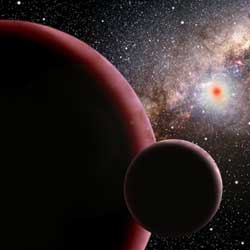
Artist illustration of a super Earth. Image credit: CfA. Click to enlarge.
Nearly all the extrasolar planets discovered have been Jupiter-sized or larger. But astronomers from the Harvard-Smithsonian Center for Astrophysics think that super-earths – rocky planets several times larger that our planet – might actually be much more common. Based on the recent discovery of a super-earth around a red dwarf star 9,000 light-years away, the research team calculated that there are probably 3 times as many of these planets than the larger gas giants.
Astronomers have discovered a new “super-Earth” orbiting a red dwarf star located about 9,000 light-years away. This newfound world weighs about 13 times the mass of the Earth and is probably a mixture of rock and ice, with a diameter several times that of Earth. It orbits its star at about the distance of the asteroid belt in our solar system, 250 million miles out. Its distant location chills it to -330 degrees Fahrenheit, suggesting that although this world is similar in structure to the Earth, it is too cold for liquid water or life.
Orbiting almost as far out as Jupiter does in our solar system, this “super-Earth” likely never accumulated enough gas to grow to giant proportions. Instead, the disk of material from which it formed dissipated, starving it of the raw materials it needed to thrive.
“This is a solar system that ran out of gas,” says Harvard astronomer Scott Gaudi of the Harvard-Smithsonian Center for Astrophysics (CfA), a member of the MicroFUN collaboration that spotted the planet.
The discovery is being reported today in a paper posted online at http://arxiv.org/abs/astro-ph/0603276 and submitted to The Astrophysical Journal Letters for publication.
Gaudi performed extensive data analysis that confirmed the existence of the planet. Further analysis simultaneously ruled out the presence of any Jupiter-sized world in the distant solar system.
“This icy super-Earth dominates the region around its star that, in our solar system, is populated by the gas giant planets,” said first author Andrew Gould (Ohio State University), who leads MicroFUN.
The team also calculates that about one-third of all main sequence stars may have similar icy super-Earths. Theory predicts that smaller planets should be easier to form than larger ones around low-mass stars. Since most Milky Way stars are red dwarfs, solar systems dominated by super-Earths may be more common in the Galaxy than those with giant Jupiters.
This discovery sheds new light on the process of solar system formation. Material orbiting a low-mass star accumulates into planets gradually, leaving more time for the gas in the protoplanetary disk to dissipate before large planets have formed. Low-mass stars also tend to have less massive disks, offering fewer raw materials for planet formation.
“Our discovery suggests that different types of solar systems form around different types of stars,” explains Gaudi. “Sun-like stars form Jupiters, while red dwarf stars only form super-Earths. Larger A-type stars may even form brown dwarfs in their disks.”
Astronomers found the planet using a technique called microlensing, an Einsteinian effect in which the gravity of a foreground star magnifies the light of a more distant star. If the foreground star possesses a planet, the planet’s gravity can distort the light further, thereby signaling its presence. The precise alignment required for the effect means that each microlensing event lasts for only a brief time. Astronomers must monitor many stars closely to detect such events.
Microlensing is sensitive to less massive planets than the more common planet-finding methods of radial velocity and transit searches.
“Microlensing is the only way to detect Earth-mass planets from the ground with current technology,” says Gaudi. “If there had been an Earth-mass planet in the same region as this super-Earth, and if the alignment had been just right, we could have detected it. By adding one more two-meter telescope to our arsenal, we may be able to find up to a dozen Earth-mass planets every year.”
The OGLE (Optical Gravitational Lensing Experiment) collaboration initially discovered the microlensed star in April 2005 while peering in the direction of the galactic center, where both foreground and background stars are widespread. OGLE identifies several hundred microlensing events per year, however only a small fraction of those events yield planets. Gaudi estimates that with one or two additional telescopes located in the southern hemisphere to monitor the galactic center, the planet count could jump drastically.
The discovery was made by 36 astronomers, including members of the MicroFUN, OGLE, and Robonet collaborations. The name of the planet is OGLE-2005-BLG-169Lb. OGLE-2005-BLG-169 refers to the 169th microlensing event discovered by the OGLE Collaboration toward the Galactic bulge in 2005, and “Lb” refers to a planetary mass companion to the lens star.
Crucial roles in the discovery were played by OGLE team leader Andrzej Udalski of Warsaw University Observatory and graduate students Deokkeun An of Ohio State and Ai-ying Zhou of Missouri State University. Udalski noticed that this microlensing event was reaching a very high magnification on May 1, and he quickly alerted the MicroFUN group to this fact, since high magnification events are known to be very favorable for planet detection. MicroFUN’s regular telescopes were unable to get many images, so MicroFUN leader Gould called the MDM Observatory in Arizona where An and Zhou were observing. Gould asked An and Zhou to obtain a few measurements of the star’s brightness over the course of the night, but instead An and Zhou made more than 1000 measurements. This large number of MDM measurements was crucial for the determination the observed signal must really be due to a planet.
Original Source: CfA News Release
Block Starlight to See Planets
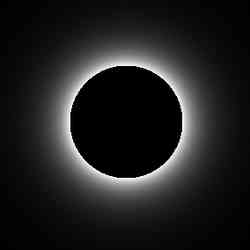
Computed intensity of vortex coronagraph for a single point-like source. Image credit: Grover Swartzlander. Click to enlarge
“Some people say that I study darkness, not optics,” jokes Grover Swartzlander.
But it’s a kind of darkness that will allow astronomers to see the light.
Swartzlander, an associate professor in The University of Arizona College of Optical Sciences, is developing devices that block out dazzling starlight, allowing astronomers to study planets in nearby solar systems.
The devices also may prove valuable to optical microscopy and be used to protect camera and imaging systems from glare.
The core of this technology is an “optical vortex mask” – a thin, tiny, transparent glass chip that is etched with a series of steps in a pattern similar to a spiral staircase.
When light hits the mask dead on, it slows down more in the thicker layers than in thinner ones. Eventually, the light is split and phase shifted so some waves are 180 degrees out of phase with others. The light spins through the mask like wind in a hurricane. When it reaches the “eye” of this optical twister, light waves that are 180 degrees out of phase cancel one another, leaving a totally dark central core.
Swartzlander says this is like light following the threads of a bolt. The pitch of the optical “bolt” – the distance between two adjacent threads – is critical. “We’re creating something special where the pitch should correspond to a change in the phase of one wavelength of light,” he explained. “What we want is a mask that essentially cuts this plane, or sheet, of incoming light and curls it up into a continuous helical beam.”
“What we’ve found recently is knock-your-socks-off amazing from a theoretical point of view,” he added.
“Mathematically, it’s beautiful.”
Optical vortices are not a new idea, Swartzlander noted. But it wasn’t until the mid 1990s that scientists were able to study the physics behind it. That’s when advances in computer-generated holograms and high-precision lithography made such research possible.
Swartzlander and his graduate students, Gregory Foo and David Palacios, garnered media attention recently when “Optics Letters” published their article on how optical vortex masks might be used on powerful telescopes. The masks could be used to block starlight and allow astronomers to directly detect light from a 10-billion-times-dimmer planet orbiting the star.
This could be done with an “optical vortex coronagraph.” In a traditional coronagraph, an opaque disk is used to block a star’s light. But astronomers who are searching for faint planets near bright stars can’t use the traditional coronagraph because glare from starlight diffracts around the disk obscuring light reflected from the planet.
“Any small amount of diffracted light from the star is still going to overwhelm the signal from the planet,” Swartzlander explained. “But if the spiral of the vortex mask coincides exactly with the center of the star, the mask creates a black hole where there is no scattered light, and you’d see any planet off to the side.”
The UA team, which also included Eric Christensen from UA’s Lunar and Planetary Lab, demonstrated a prototype optical vortex coronagraph on Steward Observatory’s 60-inch Mount Lemmon telescope two years ago. They couldn’t search for planets outside our solar system because the 60-inch telescope isn’t equipped with adaptive optics that corrects for atmospheric turbulence.
Instead, the team took pictures of Saturn and its rings to demonstrate how easily such a mask could be used with a telescope’s existing camera system. A photo from the test is online at Swartzlander’s website, http://www.u.arizona.edu/~grovers.
Optical vortex coronagraphs could be valuable to future space telescopes, such as NASA’s Terrestrial Planet Finder (TPF) and the European Space Agency’s Darwin mission, Swartzlander noted. The TPF mission will use space-based telescopes to measure the size, temperature, and placement of planets as small as the Earth in the habitable areas of distant solar systems.
“We’re applying for grants to make a better mask – to really ramp this thing up to get better quality optics, Swartzlander said. “We can demonstrate this now in the lab for laser beams, but we need a really good-quality mask to get closer to what’s needed for a telescope.”
The big challenge is developing a way to etch the mask to get “a big fat zero of light” at its core, he said.
Swartzlander and his graduate students are doing numerical simulations to determine the proper pitch for helical masks at the desired optical wavelengths. Swartzlander has filed a patent for a mask that covers more than one wavelength, or color of light.
The U.S. Army Research Office and State of Arizona Proposition 301 funds support this research.
The Army Research Office funds basic optical sciences research, although Swartzlander’s work also has practical defense applications.
Optical vortex masks also could be used in microscopy to enhance the contrast between biological tissues.
Original Source: UA News Release
Nearby Exoplanet is Scorching Hot
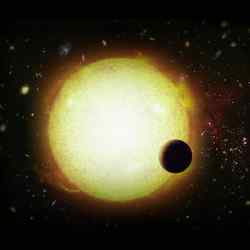
Artist’s concept of planet orbiting a star. Image credit: NASA Click to enlarge
A NASA-led team of astronomers have used NASA’s Spitzer Space Telescope to detect a strong flow of heat radiation from a toasty planet orbiting a nearby star. The findings allowed the team to “take the temperature” of the planet.
“This is the closest extrasolar planet to Earth that has ever been detected directly, and it presents the strongest heat emission ever seen from an exoplanet,” said Drake Deming of NASA’s Goddard Space Flight Center, Greenbelt, Md. Deming is the lead author of a paper on this observation to be published in the Astrophysical Journal on June 10. An advance copy of the paper will be posted on the astro-ph website on Feb. 22.
The planet “HD 189733b” orbits a star that is a near cosmic neighbor to our sun, at a distance of 63 light years in the direction of the Dumbbell Nebula. It orbits the star very closely, just slightly more than three percent of the distance between Earth and the sun. Such close proximity keeps the planet roasting at about 844 Celsius (about 1,551 Fahrenheit), according to the team’s measurement.
The planet was discovered last year by Francois Bouchy of the Marseille Astrophysics Laboratory, France, and his team. The discovery observations allowed Bouchy’s team to determine the planet’s size (about 1.26 times Jupiter’s diameter), mass (1.15 times Jupiter), and density (about 0.75 grams per cubic centimeter). The low density indicates the planet is a gas giant like Jupiter.
The observations also revealed the orbital period (2.219 days) and the distance from the parent star. From this distance and the temperature of the parent star, Bouchy’s team estimated the planet’s temperature was at least several hundred degrees Celsius, but they were not able to measure heat or light emitted directly from the planet.
“Our direct measurement confirms this estimate,” said Deming. This temperature is too high for liquid water to exist on the planet or any moons it might have. Since known forms of life require liquid water, it is unlikely to have emerged there.
Last year, Deming’s team and another group based at the Harvard-Smithsonian Center for Astrophysics used Spitzer to make the first direct detection of light from alien worlds, by observing the warm infrared glows of two other previously detected “Hot Jupiter” planets, designated HD 209458b and TrES-1.
Infrared light is invisible to the human eye, but detectable by special instruments. Some infrared light is perceived as heat. Hot Jupiter planets are alien gas giants that zip closely around their parent stars, like HD 189733b. From their close orbits, they soak up ample starlight and shine brightly in infrared wavelengths.
Deming’s team used the same method to observe HD 189733b. To distinguish the planet’s glow from its hot parent star, the astronomers used an elegant method. First, they used Spitzer to collect the total infrared light from both the star and its planet. Then, when the planet dipped behind the star as part of its regular orbit, the astronomers measured the infrared light coming from just the star. This pinpointed exactly how much infrared light belonged to the planet. Under optimal circumstances this same method can be used to make a crude temperature map of the planet itself.
“The heat signal from this planet is so strong that Spitzer was able to resolve its disk, in the sense that our team could tell we were seeing a round object in the data, not a mere point of light,” said Deming. “The current Spitzer observations cannot yet make a temperature map of this world, but more observations by Spitzer or future infrared telescopes in space may be able to do that.”
Deming’s team includes Joseph Harrington, Cornell University, Ithaca, N.Y.; Sara Seager, Carnegie Institution of Washington; and Jeremy Richardson, NASA Postdoctoral Fellow at Goddard, in the Exoplanets and Stellar Astrophysics Laboratory.
NASA’s Jet Propulsion Laboratory, Pasadena, Calif., manages the Spitzer Space Telescope mission for the agency’s Science Mission Directorate. Science operations are conducted at the Spitzer Science Center at Caltech. JPL is a division of Caltech.
Original Source: NASA News Release
Icy Extrasolar Planet Discovered
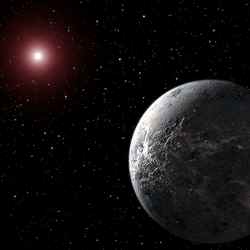
An artist’s illustration shows the extrasolar planet orbiting a dim star. Image credit: NASA Click to enlarge
Using a relatively new planet-hunting technique that can spot worlds one-tenth the mass of our own, researchers have discovered a potentially rocky, icy body that may be the smallest planet yet found orbiting a star outside our solar system.
The discovery suggests the technique, gravitational microlensing, may be an exceptional technology for finding distant planets with traits that could support life.
“This is an important breakthrough in the quest to answer the question ‘Are we alone?'” said Michael Turner, assistant director for the National Science Foundation (NSF) mathematical and physical sciences directorate. “The team has discovered the most Earth-like planet yet, and more importantly, has demonstrated the power of a new technique that is sensitive to detecting habitable planets. It can probe a much greater portion of our galaxy and is complementary to other techniques.”
Located more than 20,000 light years away in the constellation Sagittarius, close to the center of our Milky Way galaxy, planet OGLE-2005-BLG-390Lb is approximately five-and-a-half times the mass of Earth.
Orbiting a star one-fifth the mass of the sun at a distance almost three times that of Earth’s orbit, the newly discovered planet is frigid: the estimated surface temperature is -364 degrees Fahrenheit (-220 degrees Celsius).
Although astronomers doubt this cold body could sustain organisms, researchers believe gravitational microlensing will bring opportunities for observing other rocky planets in the “habitable zones” of stars – regions where temperatures are perfect for maintaining liquid water and spawning life.
The discovery, authored by 73 collaborators from 32 institutions, appears in the Jan. 26 issue of the journal Nature.
OGLE (Optical Gravitational Lensing Experiment) project telescopes first observed the lensing event on July 11, 2005. In an attempt to catch microlensing events as they occur, OGLE scans most of the central Milky Way each night, discovering more than 500 microlensing events per year. But to detect the signature of low-mass planets, astronomers must observe these events much more frequently than OGLE’s one survey per night.
So, when OGLE detected the July 11 lensing, its early warning system alerted fellow astronomers across the globe to microlensing event OGLE-2005-BLG-390 (for the 390th galactic bulge OGLE discovered in 2005). At that point, though, no one knew a planet would emerge.
“The only way to realize the full scientific benefit of our observations is to share the data with our competition,” said co-author Bohdan Paczynski of Princeton University, who along with Andrzej Udalski of Warsaw University Observatory and their colleagues co-founded OGLE in 1997.
The telescopes of PLANET (Probing Lensing Anomalies NETwork) and RoboNet tracked the July 11 episode to completion, providing the data that confirmed the presence of a previously unknown planet. These telescopes collect observations more frequently in an attempt to detect the microlensing signature of planets.
“This discovery was possible because the sun never rises on the PLANET collaboration,” said lead author and PLANET researcher Jean-Philippe Beaulieu of the Institut d’Astrophysique de Paris, France. “The global nature of the PLANET collaboration was crucial for obtaining data throughout the 24-hour planetary signal,” he added.
Ironically, when preparing the final report, the researchers discovered that during its test runs, the new MOA (Microlensing Observations in Astrophysics) telescope, MOA-2, had taken additional measurements of the lensing event. The 6-foot (1.8-meter) aperture telescope has a wider field-of-view than the OGLE telescope, enabling it to observe 100 million stars many times per night. MOA-2 is one of several recent and future advancements that gravitational microlensing proponents hope will greatly increase the number of Earth-like planet discoveries.
OGLE also has plans to increase the field-of-view of its own telescope, and other microlensing groups are proposing to build a new telescope in South Africa. They have also proposed a space mission to see planets as small as Mars as well as free-floating planets that no longer orbit a host star.
“The new discovery provides a strong hint that low-mass planets may be much more common than Jupiters,” said co-author and PLANET researcher David Bennett of the University of Notre Dame. Most extrasolar planets found so far have been Jupiter-sized.
“Microlensing should have discovered dozens of Jupiters by now if they were as common as these five-Earth-mass planets. This illustrates the primary strength of the gravitational microlensing method: its ability to find planets of low-mass,” Bennett said.
Low-mass planets can yield signals that are too weak to detect with other methods. With microlensing, the signals of low-mass planets are rare but not weak. Thus, the rate of low-mass planet discoveries should increase dramatically if more microlensing events can be searched for planetary signals.
Original Source: NSF News Release
